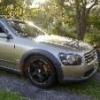M35 Stagea intake suction pipe
Announcements
-
Similar Content
-
Latest Posts
-
Don't do it if your gearbox box has already having syncro issues. The short hifter will put a greater load on them. If you must I remember Nismo did a shorter shifter, with the top part being physically shorter and the part that went into the gearbox was the same as stock. In saying that I've had a C's short shifter (I think) in mine for many years, which was given to me as the previous owner was not sympathetic to the gearbox. Thus forwarned I was careful and had to modify my normal changing style. You have to be super accurate with your clutch and shifts
-
Well, after a week of daily driving and having to crawl out between the wheel and the side intrusion bars. I got myself a quick release setup. I went with an NRG short hub and Quick Release with some cute heart cutouts on the pull tabs. Nice and matchy matchy with the rest of the interior accents I have going on. The only downside is the total stack height even with the short adapter is longer than the old HKB boss kit. Luckily I had some adjustment left on the column so move the wheel away.
-
By robbo_rb180 · Posted
stock shifter with new bushes, springs and cup will improve it. Gktech do all the bits. The opinion as the years have gone on is the redline is not great in old gearboxes. -
By drifter17a · Posted
Hi all what short shifter do you use on your skykine r34? my synchronous does have a problem and i was getting huge delay and grinding sound between 2nd and 3rd, did put shockproof red heavy stuff and it is great now/ no issues would in your view short shifter screw this up? people seems to suggest/ use cube short shifter and there is standard and premium. Seen review of premium as much better and less play. Thoughts? -
Yeah, there's a bit of a density and friability difference between pebbles and any of those other things. Silicone will definitely float in oil and so will be mobile enough to move around. Although, again, if it is upstream of the filter it really shouldn't go any further. I would only ever worry about silicone when it is in places downstream of the filter. Upstream of the pickup is a whole 'nother matter. We've all seen what that does. I have seen the most abominable crap settled out in industrial gearboxes, trunnion lube systems and the like, without any sign that any of it has touched anything in the machine. Just chilling in the bottom, waiting for the inevitable operator error that causes the whole machine to need to be dismantled for repairs.
-






Recommended Posts
Create an account or sign in to comment
You need to be a member in order to leave a comment
Create an account
Sign up for a new account in our community. It's easy!
Register a new accountSign in
Already have an account? Sign in here.
Sign In Now